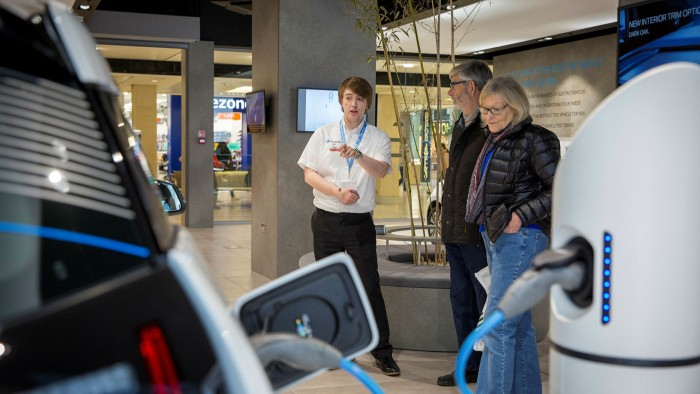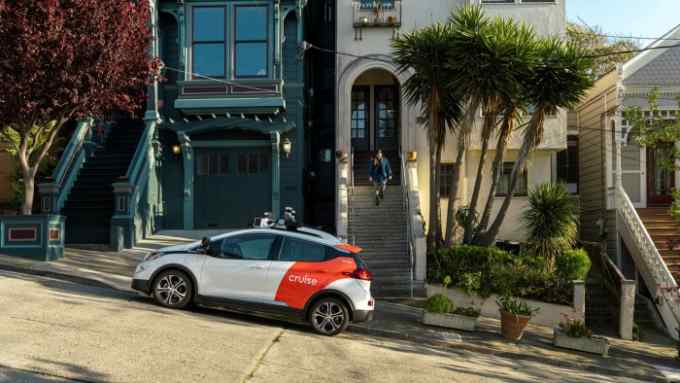Q&A: Accelerating electric vehicle adoption

Simply sign up to the Electric vehicles myFT Digest -- delivered directly to your inbox.
Richard Bartlett, BP’s head of future mobility, Rainer Feurer, BMW senior executive, Ginny Buckley, founder of consumer advice platform electrifying.com, and Julia Poliscanova, senior director at campaign group Transport and Environment, spoke to Peter Campbell, FT global motor industry correspondent, at FT Live’s Future of the Car conference last month.
Here is an edited transcript of their discussion
Peter Campbell: Electric vehicle sales in Europe have overtaken diesel, which was unthinkable two years ago. There’s still a long way to go, though, before electric cars are ubiquitous. What needs to change, between now and then, on the infrastructure side?
Richard Bartlett: Companies like BP are laying down fast-charging infrastructure at pace. Two pieces — I call it the electrification equation — need to come together.
The first is the OEMs [original equipment manufacturers] and the production of EVs. There are a lot of customers ordering EVs, but the supply chain is not there to meet the demands. In parallel to that, you’ve got the CPOs, the charge point operators, of which we’re one . . . [it’s a question of ] the pace at which we can lay down that infrastructure.
And we have a view that, to eliminate range anxiety, you need that ubiquitous charging infrastructure. You need the right speed for the right need. Doesn’t mean everyone wants to fast charge, but also doesn’t mean everyone wants to slow charge. So we’re kind of building several use cases across different platforms in different countries
Julia Poliscanova: We need to produce a lot more electric vehicles to make them more affordable.
In Europe, we also need to become energy independent a lot faster, given the aggression in Ukraine, and that means using less oil. We did analysis where we show, if we go a lot faster in the 2020s on EVs, we can save over half a billion of barrels of oil. That’s really what’s missing — this acceleration in this decade.
How do we get there? So, infrastructure, absolutely, but first, I’d like to mention supply chains, and in particular, critical raw materials . . . [such as] . . . battery-grade nickel, lithium. We can accelerate the short-term: we can produce 20 million battery electric vehicles more or less globally in 2025. That’s a lot more than carmakers are planning . . .
We know how to get global critical raw materials. We just need to put the diplomatic muscle into doing that instead of fossil fuels. And carmakers also, ultimately, should do a lot more. They basically should be partnering, and working, and even partially becoming miners.
Last but not least, charging is critical, and that’s where collaboration and partnerships are really important. I think the next big challenge in charging is [on the] private side, [the] building codes, working with grid operators, everyone together.
PC: Rainer, BMW thinks about half of its vehicles will be fully electric by 2030 but has one of the slowest transitions [to EVs anticipated]. Is that because you think these [prerequisites] won’t be ready?
Rainer Feurer: We say: if you want to create this customer experience, let’s not start just at the electric vehicle . . . we need to look at the whole backbone. So, we’re at the moment working on creating a digital charging experience, which allows us to charge at 300,000 charge points in 32 countries because you don’t just want to charge at home or at your local provider. And this takes time to build.
We really are aware that this can only be done with co-operation. We also need to work with NGOs and the regulators . . . because, if you don’t have that in place, we will not get to the situation that the customer gets a great experience. And that means at home, at work, but also [in] public.
Would it be easy to produce [more] cars? Yes, you could, of course, do more cars short term, but this transition needs to be managed carefully. [This] is not a sprint. This is more a marathon, and we need to manage that.
PC: What needs to change?
Ginny Buckley: Education is the key. We’ve got to where we are with some easy wins with early adopters, enthusiasts, people that are very tech savvy. We’re moving on now to the mainstream group . . . and they’re going to be much harder to win over.
They’re not going to put up with broken chargers, with chargers that they can’t find. They want filling up their car with electricity to be as easy as it is filling it up with petrol or diesel.
I think government needs to communicate more with consumers. I think the OEMs and the dealers need to communicate more with consumers, and I also do think the charging operators do, as well.
Consumers have got to get their heads around a lot of different things and make a lot of new habits.
PC: [With EVs] . . . it’s a different way of thinking about refuelling. Is that a jump that mainstream car buyers are going to be willing to make? Or does the industry have to move to meet them?
GB: We’re asking people to change their driving habits completely, to understand tariffs, and charging rates, and AC and DC . . . this next group are going to have to be fully supported in it and shown that it doesn’t have to be too difficult.
PC: How is charging going to evolve? At the moment, if you buy an electric vehicle, you’re charging at home almost all the time.
RB: Over 50 per cent of our global [charging] network is rapid or ultra fast, but 95 per cent of the electrons sold are on the rapid and ultra fast. So what the data tells us, in all markets, is that the customers are saying: ‘I don’t want to sit there overnight unless I’m parked on my drive.’ I want speed, convenience, safety, illumination, and other amenities.
So will streetlamp charging have a place role to play? 100 per cent. Will people want to charge at home? Absolutely. But, to have mass adoption of EVs, you can’t just rely on that.
GB: I really worry that we are not levelling up when it comes to the uptake of the electric car. A third of the UK doesn’t have access to off-street parking. So we crunched the numbers recently . . . if you don’t currently have access to off-street parking, it can cost you up to £1,000 a year more to make the switch.
Those that don’t have off-street parking tend to be in less affluent areas or in cities, the very place that, of course, driving net zero emission vehicles can do the most good. We need to be creative. The government needs, perhaps, to look at incentivising, reducing VAT.
JP: If we look at the market today, it’s not customer acceptance that’s missing. It’s actually electric cars that are missing. Carmakers and dealers have to get better at selling these cars. Sometimes, they’re still very eager to sell you that petrol or diesel car because they have higher margins on that. However, it is the supply of vehicles that is really not keeping up pace.
This is where policy regulation is so important . . . if we don’t increase the targets in 2020s, we will simply not have European electric cars to buy in Europe. Maybe we’ll have lots of Chinese on offer, but that’s not something I believe European industry wants to see.
PC: Who, at the moment, in your opinion, is not pulling their weight in [the transition to EVs]?
JP: I would say that regulators should be much more ambitious. I think it is the regulator’s job to set clearly the target, not just in 2035 but also in 2025, in 2027 so we really know now. And the second actors I would call out would be some carmakers and some auto parts makers because, actually, the entire value chain needs to change: the jobs, the skills, raw materials. That’s a huge job.
RB: I think everyone’s trying to pull their weight. [But] I’ve got chargers — brand new chargers, brand new infrastructure — sitting with wrappers on at the moment because they can’t get the last grid paperwork signed off. Some of them have been there for six to nine months. Same in Germany, same in China. It’s got to change.
PC: Rainer, who’s not pulling their weight?
RF: I think, at the moment, everybody’s pulling their weight, everybody’s moving now. That was different to two years ago. So we now have demand from the customer side . . . at the moment, more demand than supply, which I think is a good thing because, in this transition, if you don’t have pull, it’s hard. You cannot force people to buy something. You cannot force people to make your charger available.
I would also say we need more speed in regulation — because it gives you the speed you need and also the investment security you need for all the players.
GB: I think government needs to help with education. I think OEMs and energy companies need to talk more so that we have cars that can access off-peak charging rates. It’s astonishing to me that some of the best-selling electric cars, you can’t choose to charge them off-peak and take advantage of cheaper tariffs.
And we do need charging infrastructure that is reliable because it gives confidence to the consumer. It’s that old adage: one happy customer tells their friends; one unhappy customer tells the whole world. We cannot afford to have consumers lose confidence in this transition.
The above transcript has been edited for brevity and clarity

Comments